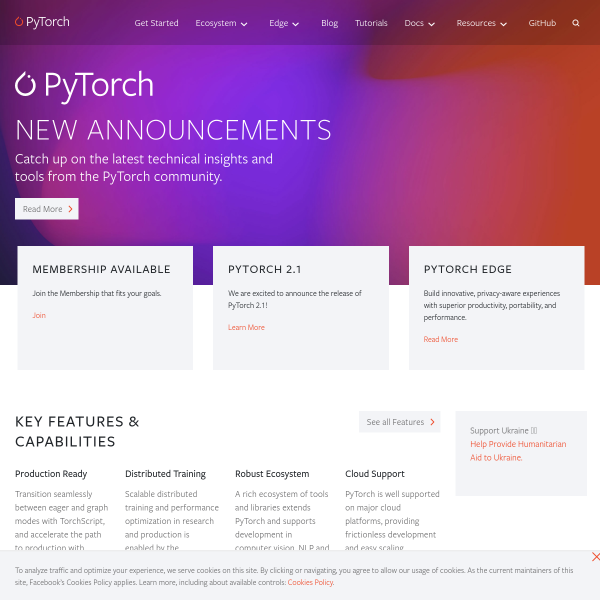About PyTorch.org
PyTorch is a free and open-source machine learning library released in January of 2017. PyTorch is developed by Facebook in collaboration with the AI startup, NVIDIA. PyTorch is designed for deep neural network research, enabling users to create their own cutting-edge AI models.
PyTorch has many pros. One of the biggest advantages of PyTorch is its natural, intuitive code syntax that makes it easy for users with some coding experience to quickly understand and use the library. With PyTorch, you can effortlessly switch between CPU and GPU modes as needed, allowing for better optimization when working with larger datasets. PyTorch also features a comprehensive ecosystem of libraries and tools such as TorchAudio, TorchVision, and TorchText that users interested in specific types of projects can install and quickly begin exploiting.
PyTorch also has its share of cons. One of its biggest draw-backs is its lack of support for mobile platforms such as iOS and Android, which limits the application of PyTorch models to primarily desktop or cloud-based applications. Furthermore, as PyTorch is relatively new, it has yet to catch on as widespread as some other libraries and so users, including the less experienced, may find a lack of tutorials and resources for PyTorch.
The typical user for PyTorch is a researcher or developer with some AI or coding background. PyTorch’s comprehensive set of libraries and tools is especially appealing to experienced users who want to quickly build AI-enabled applications and models, particularly when working with larger datasets.
PyTorch is owned by Facebook. Facebook released PyTorch in January 2017 in an effort to make cutting-edge AI research more accessible to the public.
Ending on a positive note, PyTorch is a powerful and well-supported AI library that is growing in popularity among researchers and developers. With intuitive syntax, memory optimization, and an ever-growing set of tools, PyTorch is an ideal solution for creating powerful AI models in no time.
Alternatives to PyTorch.org
TensorFlow:
Pros: Easier to read and use for beginners, can use Google’s powerful machine learning technology, great for larger projects or deep learning
Cons: Not as flexible for modeling, can be memory intensive
Keras:
Pros: Easy to use for beginners, great for quickly building and training models, supports multiple backends like TensorFlow and Theano
Cons: Not as customisable for building complex models, not as fast as other options.
MXNet:
Pros: Offers great scalability,has efficient memory usage, very fast with GPU learning
Cons: Not as popular as other frameworks, can be harder to learn.
FAQ – PyTorch.org
Q1: What is PyTorch?
A1: PyTorch is an open-source deep learning framework developed by the AI research group at Facebook. It provides a comprehensive set of tools for training, testing, and validating deep learning models.
Q2: What is the difference between PyTorch and Tensorflow?
A2: Tensorflow is a symbolic mathematics library while PyTorch is a deep learning library. Tensorflow supports both symbolic math and deep learning, while PyTorch focuses on deep learning.
Q3: How do I install PyTorch?
A3: You can find installation instructions for PyTorch on its website, pytorch.org.
Q4: How do I use PyTorch?
A4: You can find tutorials and documentation on how to use PyTorch on its website.
Q5: Does PyTorch support GPU?
A5: Yes! PyTorch can be used to build deep learning models that run on GPUs for increased performance.
Q6: Is PyTorch free?
A6: Yes! PyTorch is released under the Apache 2.0 open source license.
Q7: What languages does PyTorch support?
A7: PyTorch currently supports Python, C++, and Java.
Q8: Does PyTorch work with Windows?
A8: Yes, PyTorch can be installed on Windows 10 with the command line interface.
Q9: What is the difference between PyTorch and Keras?
A9: PyTorch is a deep learning framework while Keras is a high-level neural networks API. PyTorch provides more flexibility than Keras, such as support for custom layers and lower-level access to operations.
Q10: Does PyTorch support distributed training?
A10: Yes! PyTorch can be used for distributed training across multiple GPUs and machines.

Leave a Reply